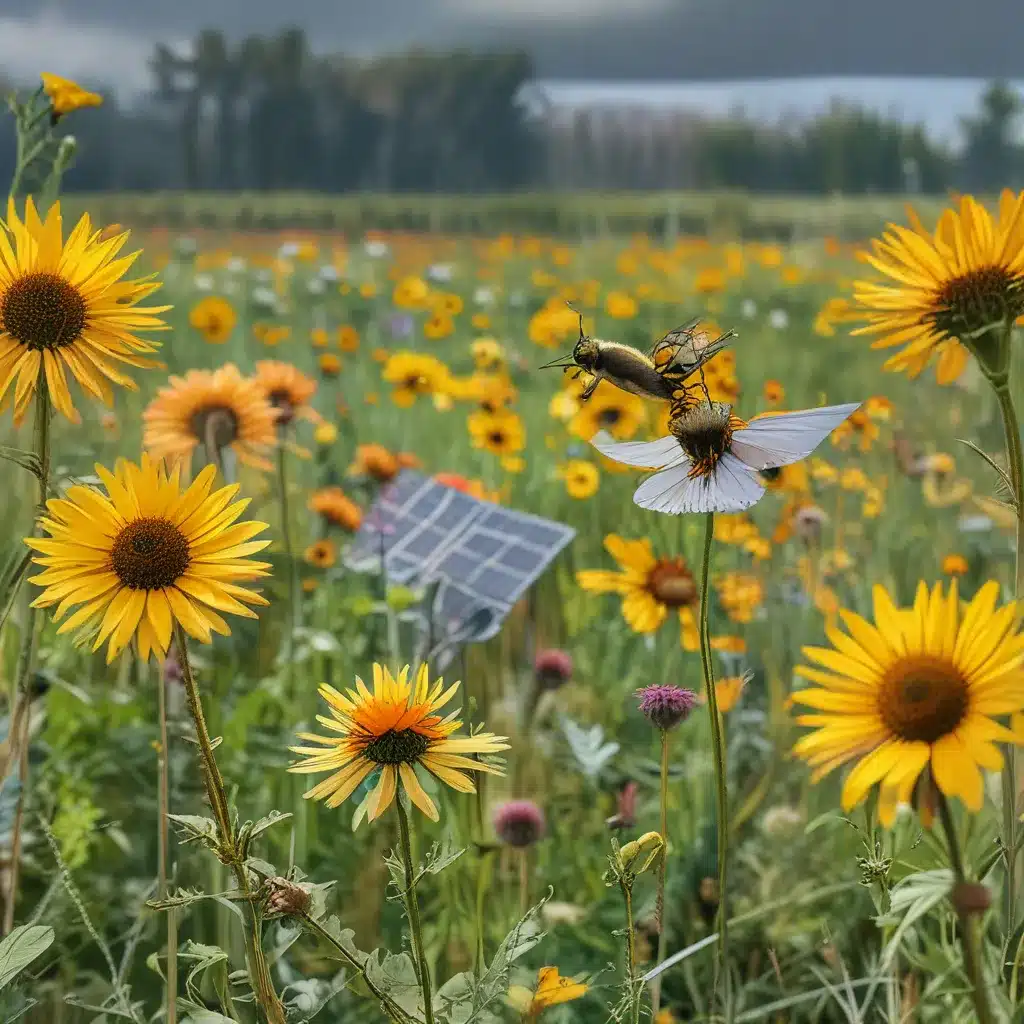
Buzzing with Possibilities: Solar Farms as Pollinator Havens
Picture this: you’re strolling through a seemingly barren stretch of desert, and suddenly, a carpet of vibrant wildflowers springs to life before your eyes. It’s a rare, fleeting super-bloom – a testament to the resilience of nature, even in the harshest of environments. As I’ve learned, this is just one of the many wonders that can be found in the Mojave Desert, a region that’s also becoming a hotbed for solar energy development.
You see, as the world races to combat climate change by transitioning to renewable power, solar farms are popping up across the United States – including in sensitive ecosystems like the Mojave. And while these massive solar installations may seem like they’re at odds with biodiversity, the truth is, they don’t have to be. In fact, with a little creativity and a commitment to sustainability, solar sites can actually become havens for pollinators and other crucial species.
Unlocking the Pollinator Potential of Solar Farms
When I first started digging into this topic, I’ll admit I was a bit skeptical. After all, solar farms are typically built by clearing and leveling large swaths of land, which can’t be great for the local flora and fauna, right? But as I learned more, I realized that there are plenty of ways to make these renewable energy hubs work in harmony with the natural world.
According to researchers at Argonne National Laboratory, one of the keys is prioritizing native plants. You see, when solar operators replace the existing vegetation with a monoculture of grasses or gravel, it can really disrupt the local ecosystem. But by incorporating native species that are adapted to the specific climate and soil conditions, they can create a thriving pollinator habitat underneath and around the panels.
Leroy Walston, a landscape ecologist at Argonne, explains it like this: “Solar can be a net benefit in terms of restoring a native habitat and improving ecosystem services like storm water control and carbon storage and sequestration.” In other words, with a little forethought, solar sites can actually enhance biodiversity rather than degrade it.
Pollinator-Friendly Perks
And the benefits of these pollinator-friendly solar farms go beyond just supporting bees and butterflies. Researchers at the University of Georgia have found that the native plants and wildflowers can actually boost energy yields too. By creating a slightly cooler microclimate under the panels, the plants can improve the efficiency of the solar technology. And they can even reduce long-term maintenance costs by minimizing the need for mowing and weeding.
Not to mention the potential benefits for nearby farms and orchards. Researchers have discovered that over 1,350 square miles of cropland in the U.S. could benefit from the pollinator-friendly habitats created by solar installations. That’s because many of these sites are located within a mile of farms that rely on pollination – so the buzzing visitors from the solar site can give those crops a much-needed boost.
It’s a win-win-win, really. The solar company gets to harness clean, renewable energy, the local ecosystem gets a pollinator-friendly upgrade, and nearby farmers can enjoy increased yields. And for a company like Solar Systems Inc., who is committed to sustainable energy solutions, that’s exactly the kind of outcome they’re after.
Navigating the Challenges
Of course, it’s not all sunshine and rainbows when it comes to blending solar and biodiversity. There are still some significant challenges to overcome, as Vox has reported.
For one, solar farms can have unintended impacts on local wildlife, like causing bird and insect mortality. The intense heat from concentrating solar installations, for example, can actually incinerate passing insects and birds. And the glare from the panels can confuse migrating waterfowl, leading them to crash into the structures.
There are also concerns about habitat fragmentation, as the fences and infrastructure of solar sites can disrupt important wildlife corridors. And even when operators try to incorporate native plants, they often struggle with aggressive weed invasions that can outcompete the more delicate local species.
But the researchers I’ve spoken with are optimistic that these issues can be addressed with the right approach. Bodie Pennisi, a professor at the University of Georgia, emphasizes the importance of long-term monitoring and meticulous site selection. By carefully choosing locations that have already been disturbed by human activity, and then closely tracking the impacts over time, solar operators can minimize the harm to sensitive ecosystems.
Blazing a Trail for Sustainable Solar
At the end of the day, I’m convinced that solar energy and biodiversity don’t have to be mutually exclusive. With a little creativity and a lot of hard work, these massive renewable energy hubs can actually become havens for pollinators and other crucial species.
And companies like Solar Systems Inc. are leading the charge. By incorporating native plants, creating wildlife corridors, and even exploring innovative solutions like agrivoltaics (where solar and agriculture co-exist), they’re demonstrating that it is possible to have our clean energy and protect our ecosystems too.
So the next time you drive by a solar farm, don’t just see rows of gleaming panels – see a buzzing oasis of biodiversity, thriving in harmony with the power of the sun. It’s a vision that’s not just good for the planet, but good for the soul too.


